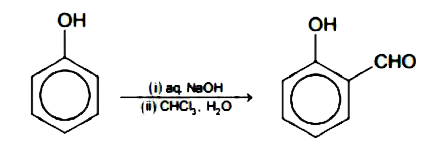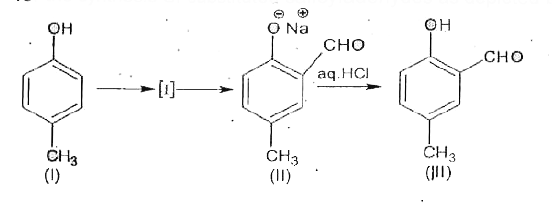
The electrophile involved in the above reaction is
A
Dichloromethyl cation (⊕CHCl2)
B
Dichlorocarbene (:CCl2)
C
Trichloromethyl anion (ΘCCl3)
D
Formyl cation (CHO)
Video Solution
Text Solution
The correct Answer is:B
|
Topper's Solved these Questions
- GENERAL ORGANIC CHEMISTRYBOOK - ERRORLESS CHAPTER - GENERAL ORGANIC CHEMISTRYEXERCISE - Structural and stereo isomerism
140 Videos
- GENERAL ORGANIC CHEMISTRYBOOK - ERRORLESS CHAPTER - GENERAL ORGANIC CHEMISTRYEXERCISE - Classification and nomenclature of organic compounds
117 Videos
- GENERAL ORGANIC CHEMISTRYBOOK - ERRORLESS CHAPTER - GENERAL ORGANIC CHEMISTRYEXERCISE - Dipole moment, resonance and reaction intermediates
73 Videos
- GASEOUS STATE BOOK - ERRORLESS CHAPTER - GASEOUS STATE EXERCISE - JEE SECTION JEE (Advanced) 2018 Numeric answer type question
1 Videos
- HALOGEN CONTAINING COMPOUNDBOOK - ERRORLESS CHAPTER - HALOGEN CONTAINING COMPOUNDEXERCISE - Critical Thinking (Jee (Advanced) 2018)
1 Videos
Similar Questions
Knowledge Check
The electrophile involved in the given reaction is:
 ACCI2B.−CCI3C.+CHOD.+CHCI2
ACCI2B.−CCI3C.+CHOD.+CHCI2The electrophile involved in the following reaciton is
 Aformyl cation (+CHO)BDichlorocarbene (:CCl2)CDichloromethul cation (+CHCl2)DTrichloromethyl cation (:−CCl3)
Aformyl cation (+CHO)BDichlorocarbene (:CCl2)CDichloromethul cation (+CHCl2)DTrichloromethyl cation (:−CCl3)
What is the intermediate involved in the above reaction ?A:CH2BCCl2C⊕CH3D⊕CCl2
The electrophile involved in the Reimer-Tiemann reaction is
View SolutionThe electrophile involved in chlorination of benzene is
View Solution
Select the reactions involved in the reaction above reaction :
View SolutionThe electrophile in nitration of benzene reaction is:
View SolutionReimer-Tiemann reaction introduces an aldehyde group, on to the aromatic ring of phenol, ortho to the hydroxyl group. This reaction involves electrophilic aromatic substitution. This is a general method for the synthesis of substituted salicyladehydes as depicted below.

The electrophile in this reaction is
View Solution


